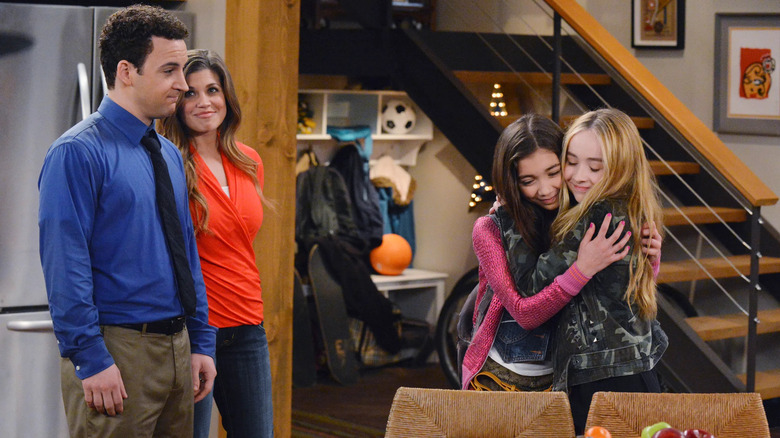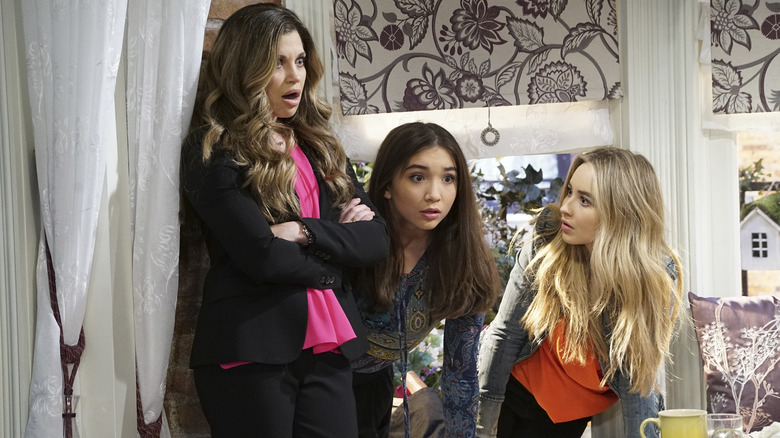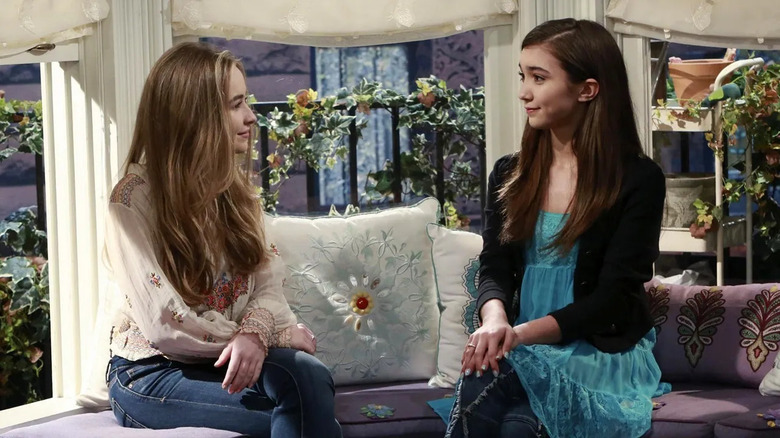The Real Reason Girl Meets World Was Canceled
As reported by /Film on January 4, 2017, the Disney Channel canceled "Girl Meets World" after three seasons. Upon completing production on the show's third season, the "Girl Meets World" cast and crew had been patiently waiting to hear whether or not their series would be renewed for a fourth go-round. Instead, the show's aptly-titled season 3 finale, "Girl Meets Goodbye," became forever known as the final episode.
If you listen to "Pod Meets World," the podcast hosted by "Boy Meets World" and "Girl Meets World" veterans Danielle Fishel, Will Friedle, and Rider Strong, you'll get the sense that Michael Jacobs — the co-creator and head executive producer on both shows — is a very dogged and focused individual who knows what he wants and will do anything to get it. So, when fans raised hell on social media, he shopped "Girl Meets World" to Netflix and other platforms. However, after four months of trying to find the show a new home, Michael Jacobs posted the following message to the "Girl Meets World" writers room Twitter/X account: "I wasn't able to find a new venue for the show. I'm sorry. We brought our best and hope we made you think and feel. Until next time. Thanks."
We'll never know what Jacobs and his writers had in mind for season 4, outside of Jacobs' vague post on Twitter/X that it would've explored "what drew Farkle, Lucas, and Zay to Riley and Maya was the deep friendship and respect they had for each other. And their relationship was the guide in how to meet the world. Especially our current world. Because to find love, friendship and respect must be at the center of it." This word salad of platitudes doesn't give us much, but it does leave us wondering why Disney pulled the rug out from under the "Girl Meets World" creators, preventing them from completing the series.
The titular girl was growing up too quickly
At the 2017 Philadelphia Comic-Con, Friedle and Strong offered their thoughts on the cancellation of "Girl Meets World." Friedle mentioned Disney's "65 and out rule," where regardless of a show's success on the Disney Channel, it is canceled after 65 episodes. This has allowed the channel to avoid paying higher fees to its writers. When some Disney series became too popular to cancel, they would be renamed or spun off into entirely new concepts, such as "Hannah Montana Forever" or "The Suite Life on Deck."
Strong also mentioned one of the key factors that led to the downfall of "Girl Meets World": as the characters progressed in age, they got further and further away from Disney's young demographic. "They want six-year-olds to be able to watch their stuff and stay with them until they're 12. When they get over 12, they start phasing out the audience, so I think they were worried 'Girl Meets World' would get into high school years, and dating, and things that 'Boy Meets World' was able to do because we were on a network," he explained. "Boy Meets World" was something that the entire family could gather in the living room to watch together and enjoy, adults and kids alike. This also meant the series could address heavier issues such as class differences, divorce, drinking, and sex. While still quite tame, "Boy Meets World" certainly wasn't the bubblegum cuteness of the Disney Channel.
In addition, Strong brought up another cancellation reason that many reports overlooked: "A lot of the Disney Channel shows could sell ancillary products — toys, if its a magic-based show, or someone on the show is a singer they can make concerts. 'Girl Meets World' didn't have any of those components." In other words, the story of an ordinary girl who was quickly becoming a young woman wasn't commercially viable enough for Disney to continue.
It was the wrong style of world
If "Girl Meets World" hadn't needed to fit the Disney Channel's syrupy, hyperactive aesthetic, it could have flourished. Its parent series, "Boy Meets World," effortlessly took Cory from a middle school student to a college age adult. The show contemplated the meaning of life with silliness, yes, but also maturity and grace. "Girl Meets World" was too sanitized, constantly spelling out what it wanted the audience to learn and making references to the world or the universe.
The show's glossy and colorful visuals also felt plastic and unreal, so far away from your everyday, middle-class life. Even its New York City setting played into that idea of fantasy and aspiration that contemporary Disney Channel shows project, implying that ordinary suburbia is now boring. The fan pandering and return of beloved "Boy Meets World" characters like Shawn (Strong), Eric (Friedle), Mr. Feeney (William Daniels), and other adults became the only bright spots of the series. The show also could have used some younger writers; Jacobs frequently took an insensitive approach to delicate topics, resulting in baffling moments where autism is treated like a cancer diagnosis or problematic lessons about communism making people unmotivated.
A sequel series to "Boy Meets World" never needed to only target a younger demographic. It should have been made for millennials to enjoy themselves and share with their kids — even if streaming has transformed the television landscape, with the idea of family sitcoms and the ritual of families watching them all together fades each year. At the very least, if "Girl Meets World" had aired on another network or streaming service, it could have been less childish and hokey. The Disney Channel was never the right home for "Girl Meets World," so it's no surprise that it was canceled prematurely.


